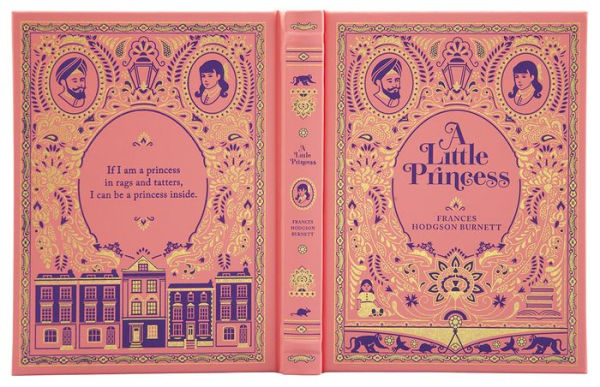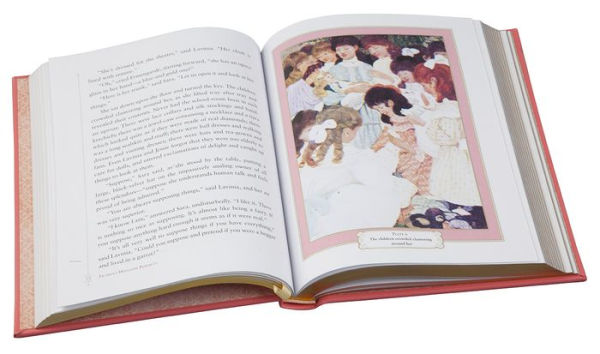Mark(ing It All)Down
On A Little Princess (specifically, the Barnes & Noble Collectible Editions edition)

“This edition is one of Barnes & Noble’s Collectible Editions classics for young readers. It features the full color art of Ethel Franklin Betts, an elegant bonded-leather binding, a ribbon bookmark, and distinctive gilt edging. This volume will provide hours of pleasure for readers of all ages.”
Upon perusing my long-abandoned bookshelf—filled from edge to edge and top to bottom with books of varying lengths, widths, and contents—I came across my copy of Frances Hodgson Burnett’s A Little Princess, the classic tale of little Sara Crewe’s experiences attending boarding school under the cruelty of Miss Michin, following her father’s untimely death.
At first glance, the book establishes itself as one made to draw attention, as is typical of other Barnes & Noble Collectible Editions volumes. With its bright pink color, illustrated leatherbound cover featuring black and gold detailing, gold page edges, and yellow ribbon bookmark, it was clearly intended to function extremely well as a display-piece that was as visually-appealing as it was intellectually-stimulating (in terms of containing an interesting subject matter, in my opinion, at least).
“The paper was to be of hand-made linen, from the Kelmscott Mills; the type blackletter, with rubricated initials. The cover, which was Baxter’s own selection, was to be of dark green morocco, with a cap-and-bells border in red inlays, and doublures of maroon morocco with a blind-tooled design.” - Charles W. Chesnutt, “Baxter’s Procrustes”
The book itself is weighty but not heavy, larger than pocketsized but not completely untransportable; it’s obvious that it was made to resemble a classic hardbound textual artifact. One example, in particular, would be the back cover of the book. Surrounded by a rectangular illustration that nearly fills the entire space, silhouetted by an oval-shaped design, a quote from the book—Sara’s iconic declaration that “If I am a princess in rags and tatters, I can be a princess inside.”—lies in the center of it all.
Not only does the quote serve as a direct reference to the contents and moral of Burnett’s story, but it also greatly resembles the metal plate engravings used in books produced through letterpress-printing, in which the center of the design was purposely left empty so that the printers could fill it with text at a later stage, as set by the compositors. It is easy to picture this book proudly standing alongside the many other titles featured in a salesman’s samples, being marketed in a much thinner form with chapter snippets and the spine printed as a leaf attached to the book’s cover.

In addition to the plate-like back cover design, the interior of the book features a “List of Plates,” a glossary for the twelve illustrations incorporated into the organization of the book’s pages, all of which come captioned with a specific quote from the text itself. Undoubtedly, this must have been a nod (or, in a more enthusiastic and self-assured self, a violent tossing-forward of the head) towards the engraved metal illustrations that would be included within its predecessors as well.
Arguably, however, it seems unlikely that this book was primarily intended for those unfamiliar with A Little Princess. Given that it is labeled as a “collector’s item” and contains little to no information about the book (i.e. a synopsis of any kind, or a section regarding the author’s other publications and/or achievements, etc.) other than the chapter headings, illustration titles, and text of the story itself. Paired with its highly-stylized design, it is as though this book was meant to be purchased with the intention of being kept without necessarily being read.
‘By 1887, an article titled “Literary Voluptuaries” could declare that “the collector is curious about margins, typography, and casings, but comparatively indifferent to contents” (805). Cover and content, authenticity and appearance: the language of insides and outsides makes any consciousness of the book’s material qualities signify moral shallowness. Leather bindings rub off on their skin-deep owners.’ - Leah Price, “Introduction” to How to Do Things with Books in Victorian Britain
Furthermore, what distinguishes this book from its historical counterparts is that its gilt-edging serves an aesthetic purpose, whereas it previously would’ve been a method of keeping the pages pristine and flat. Similarly, the ribbon bookmark harkens back to copies of Bibles and prayer books, though many readers may opt for a separate bookmark of their own instead. This iteration of A Little Princess also features rubricated initials at the beginning of each chapter, and wallpaper-patterned endsheets, alluding to the ornate, “fanciful” quality of books from the past.
Yet, despite these historical influences, the book itself feels greatly manufactured, lacking the traces of human labor and handiwork as can be found in older copies of this text. The paper is glossy and contains none of the lined markings typically present in laid paper; there are no printer’s marks or watermarks, and no obviously-determinable indicators of book size (i.e. folio, quarto, octavo, etc.); everything was churned out by a machine, all smooth and pretty and picture-perfect.
In this sense, having previously viewed historical copies of books during class, this book feels almost… gaudy. It has a distinctive sleekness and polish to it that clearly sets it apart from older editions and versions and copies of this same text. To a certain degree, there is a severe lack of dimensionality to this book, regardless of its attempt to resemble a historical leatherbound volume—save for two horizontal bumps on its spine, made to look like the spine “hubs” found on case-bound books that were bound via sewing. This element that was previously intended to strengthen a book’s structure is now but another decorative element.
Finally, it is vital to remember that this book was mass-produced and sold for $10 as a product of a bookstore chain, presumably under the assumption that there would be sufficient demand for it; whereas, in the past, it would’ve most likely had to rely on the subscribers garnered by salesmen and the quantity of demand, and based on copyright at the time, it would’ve been a much more limited batch. Nonetheless, considering all its flashy ornamentations, I’m sure Jane Austen would not have approved.
FIELDBOOKS · MODEL
